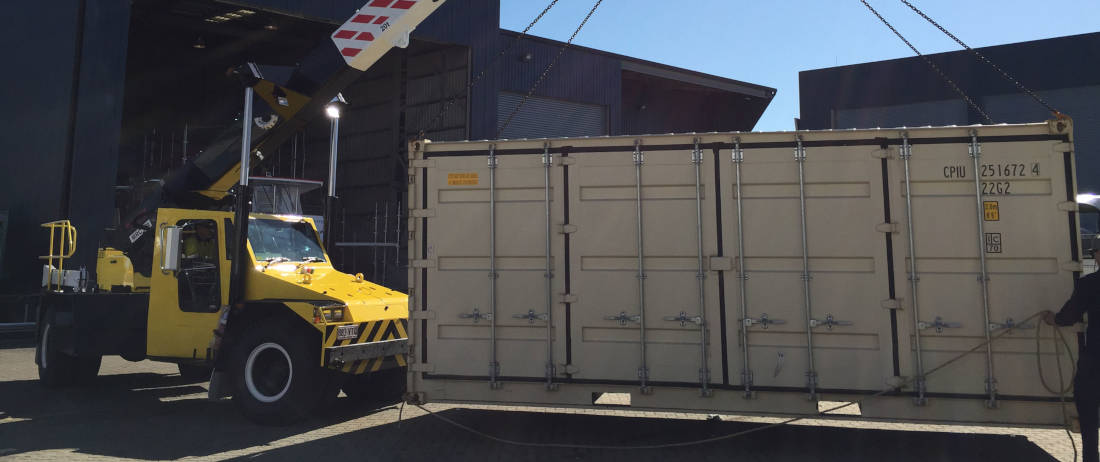
The History of Cranes
The crane has undergone a remarkable transformation throughout history, from primitive early pulley systems to modern hydraulic-powered machines. While the core objective—to lift, lower, and manoeuvre heavy objects—remains the same, technological advances mean modern-day cranes are more effective than ever before.
Yearning to learn more about how this industrial innovation came about?
In this post, we’re covering the chronological evolution of the crane, from early beginnings to cutting-edge innovations. We’ll also discuss how cranes are being used to propel the construction industry into the future.
When & Where was the Crane First Invented?
The modern-day crane evolved from the early pulley mechanism.
Ancient construction workers used these primitive devices to manoeuvre weighty objects more quickly than by hand. The pulley works by changing the direction of force, reducing the effort required to lift an object.
The people of Mesopotamia (present-day Iraq) were the first to invent a pulley system in 3,000 BC. Known as the shadouf, this lever-style mechanism enabled the Mesopotamians to lift water buckets more easily to aid irrigation.
The shadouf consists of an upright frame with a suspended, counterbalanced pole or branch on a pivot. At the end of the stick hangs a bucket or a similar container, such as a skin bag or coated reed basket.
The container sometimes has an uneven base or a section at the top the worker can untie. These designs allow the worker to instantly distribute water over a nearby area rather than manually emptying the container, thus further improving efficiency.
On the short end of the pole, a clay or stone weight works as the counterpoise of the lever. The worker pushes their weight on the lever, and then the counterweight raises the container without further exertion. Water is typically deposited into runnels, which flow towards irrigation ditches.
This near-effortless swinging and lifting motion allows the worker to scoop up and distribute water far more easily than by hand. Due to its efficient design, the shadouf rapidly became widespread in Mesopotamia for crop irrigation systems in ditches, dikes, canals, and basins.
Although primitive by modern standards, the shadouf was a revolutionary invention in the early agricultural industry. About one millennium later, the Ancient Egyptians began incorporating the design into their irrigation systems. The Chinese adopted the innovation around 1600 BC, and several other civilisations later followed suit.
Even today, many developing nations use the shadouf to hoist buckets of water more efficiently than by hand. The technology can still be observed in rural areas of India and Pakistan, as well as in numerous African nations.
The Use of Cranes through Time
Humanity has expanded on the Mesopotamian shadouf to create increasingly sophisticated leveraging mechanisms.
From Ancient Greece to the Industrial Revolution, here’s how hoisting technology has evolved over the years.
Ancient Greece
Records show the Ancient Greeks began using lifting tongs and lewis irons in their temples around 515 BC. Innovations in winches and pulleys began replacing ramps as a means of moving objects vertically.
These new lifting mechanisms saw Ancient Greek construction trend towards using more small stones rather than fewer large building blocks. Moreover, crane innovations saw the practice of erecting large monolithic columns replaced by smaller column drums.
Some historians argue the Greek shift from ramp to crane technology was spurred by the socio-political environment of the time. Unlike the autocratic societies of Ancient Egypt, the Greeks favoured small professional construction teams over large, unskilled workforces.
The compound pulley was the next step towards the modern-day crane.
Records suggest Archimedes of Syracuse created the first compound pulley system between 287 and 212 BC. This design uses a network of multiple pulleys to achieve a greater mechanical advantage. For example, two pulleys afford a 2:1 advantage, which means a single worker exerting 50kg of pressure can lift 100 kg.
The Roman Empire
Renowned for their architectural prowess, the Romans constructed thousands of enormous buildings across vast swathes of Europe, North Africa, and the Middle East. Much of this widespread construction can be credited to advancements in crane technology.
The simplest Roman crane was the trispastos, a single-beam jib with a winch, rope, and three pulleys. As it had a mechanical advantage of 3:1, a worker could lift 150 kg using 50 kg of pressure. Typically, 50kg is the maximum pressure a worker can exert over an extended period.
The Romans later invented the more advanced pentaspastos system, which had five pulleys and a 5:1 advantage. Next came the polyspastos, a three-mast system with five pulleys on each mast. Through it, four men could lift up to 3,000 kg.
When combining this system with a treadmill crane, which has a greater mechanical advantage due to its large diameter, just two workers could lift up to 6,000 kg.
These innovations allowed the Romans to lift increasingly heavy weights. The capital block in Rome’s Trajan’s Column, for example, weighs 53.3 tons and sits 34 metres high.
The Middle Ages
The demise of the Roman Empire caused the treadmill crane to fall into disuse. However, in the 13th century, the technology saw a revival throughout major European shipping harbours such as Utrecht, Antwerp, Bruges and Hamburg.
The Medieval harbour crane consisted of a pivoting structure with double treadmills powered by windlasses with radiating spokes and cranks. These immovable cranes sat dockside and served to load and unload cargo, sometimes in conjunction with earlier methods such as winches and see-saws. Variations were common between distinct regions—the Dutch, Germans, and Italians each incorporated their unique designs.
The rise of Gothic architecture also drove new crane innovations throughout Europe. The construction of grandiose cathedrals required complex pulley systems combined with treadmill cranes, which could achieve a mechanical advantage of 30:1.
Much like their earlier counterparts, medieval cranes primarily moved objects in a vertical motion.
The Industrial Revolution
Primitive hydraulic technology existed long before the dawn of the Industrial Revolution. From Chinese water wheels to Roman aqueducts, humanity had long sought to harness the power of its most precious natural resource.
In the 15th century, Blaise Pascal, a scholar of fluid hydrodynamics and hydrostatics, developed a new understanding of fluid density, pressure and incompressibility. That knowledge enabled him to invent the first hydraulic press, which laid the foundation for the modern-day hydraulic crane.
In 1838, an English industrialist named William Armstrong designed the first water-powered hydraulic crane. His initial invention incorporated a ram inside a closed cylinder, which used pressurised fluids to force the ram downward. A valve regulates fluid intake, while a mechanism called a hydraulic jigger pulls down on the chain to lift the load.
Armstrong’s invention saw near-instant success. Within a few short years, his company operated hydraulic cranes and machinery in shipyards and construction sites throughout England. The exciting new technology rapidly spread throughout Europe and the rest of the world.
During the following decades, Armstrong discovered new ways to improve his world-famous invention. For example, when water pressure wasn’t available on-site, he built tall water towers to provide a steady supply.
And where towers weren’t viable, Armstrong incorporated a hydraulic accumulator, a type of cast-iron cylinder fitted with a plunger. Slowly raising the plunger drew in water, and the downward force would push water below it through adjoining pipes. This invention enabled his cranes to force large quantities of water through pipes at considerable pressure, thus improving their load capacity.
The Modern Crane
The present-day hydraulic crane relies on the same mechanical principles developed by Armstrong almost two centuries ago. However, superior materials—notably steel and iron—and better specifications allow us to lift heavier loads to dizzying new heights.
A critical modern advancement was replacing water with an incompressible fluid such as oil. This new liquid type allowed us to more accurately transfer pressure between pistons, thus enhancing capacity and efficiency.
Another crucial innovation was the mobile crane. While mobile cranes lift smaller loads, their agile nature offers significant benefits in many construction scenarios.
Engineers used the technology during the war to move heavy military equipment and manage demolition work, among other things. In the post-war reconstruction period, mobile cranes played a pivotal role in Europe’s building boom.
These days, mobile cranes simplify and speed up construction projects, resulting in lower building costs and faster completion rates. Mobile cranes are now commonplace in the shipping, transportation, and warehousing industries, enabling us to move high volumes of merchandise at a minimal cost.
Mobile cranes come in four main types (although other variations exist):
- The truck-mounted crane features a rotating telescopic boom crane on a truck chassis.
- The rough terrain crane is designed for off-road construction and has a boom mounted above the undercarriage.
- The crawler crane has a continuous track system (similar to a tank) with a boom mounted on the undercarriage.
- The floating crane sits on a barge or pontoon for building bridges and offshore construction.
Nonetheless, fixed cranes remain common due to their ability to hoist heavier loads. Though these heavy-duty crane types don’t move while in use, they can be assembled and disassembled in various locations. Dozens of fixed crane types operate worldwide, each excelling in unique situations.
So, just how powerful does the modern-day crane get?
China’s Taisun, the most powerful fixed crane in the world, has a mind-blowing lifting capacity of 20,000 metric tonnes. The strongest telescopic boom crane on earth is the Liebherr 11200-9.1, which can lift 1,179 tons 167 metres high. Its sibling, the Liebherr LR 13000, is our most potent crawler crane—this one can lift 3,000 tons to 144 metres high.
Contact Might Cranes
If you’re looking for crane hire in the Brisbane, Logan, or Redland Bayside area, get in touch with Mighty Cranes today.
We manage a reliable fleet of Franna, Rough-Terrain, and All-Terrain cranes suitable for various projects and conditions. As a proudly locally-operated business, we put customer service at the forefront and can provide an on-site quote and comprehensive lift plan at no extra cost.
Our highly trained crane operators are fully qualified riggers and comply with all Australian safety regulations. We specialise in providing customised lifting solutions to the construction, mining, and boat-building industries.
Call us today on 0477 000 976 to see why we’ve become Brisbane’s leading crane hire company.





